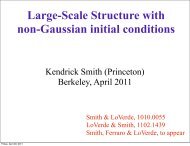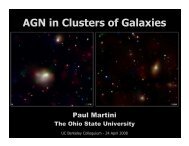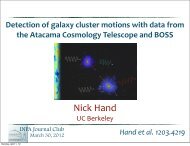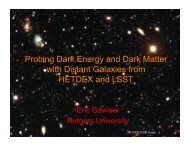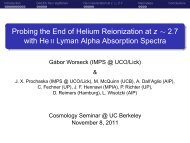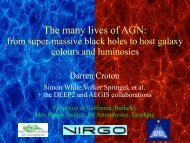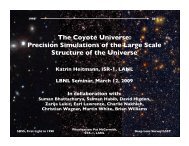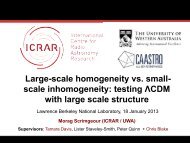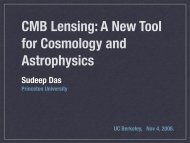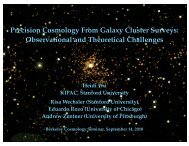Large-Scale Structure of the Universe as a Cosmic Ruler - Berkeley ...
Large-Scale Structure of the Universe as a Cosmic Ruler - Berkeley ...
Large-Scale Structure of the Universe as a Cosmic Ruler - Berkeley ...
Create successful ePaper yourself
Turn your PDF publications into a flip-book with our unique Google optimized e-Paper software.
<strong>Large</strong> <strong>Scale</strong> <strong>Structure</strong> <strong>of</strong> <strong>the</strong> <strong>Universe</strong><br />
<strong>as</strong> a <strong>Cosmic</strong> <strong>Ruler</strong><br />
<strong>Berkeley</strong> Cosmology Group<br />
February 17, 2009<br />
Changbom Park<br />
(Korea Institute for Advanced Study)<br />
<strong>Berkeley</strong> 2009. 2. 17
This Study<br />
: <strong>Large</strong>-scale structure <strong>as</strong> a cosmic ruler<br />
Motivation: To introduce a new me<strong>as</strong>ure <strong>of</strong> geometry <strong>of</strong> <strong>the</strong> universe<br />
complementary to <strong>the</strong> BAO<br />
Key Idea: In <strong>the</strong> comoving space <strong>the</strong> topology <strong>of</strong> LSS do not change in time,<br />
and can serve <strong>as</strong> a standard ruler.<br />
Equivalent to using <strong>the</strong> overall shape <strong>of</strong> <strong>the</strong> PS or CF (Gaussian)<br />
Strategy: Intrinsic topology statistics at large scales<br />
(insensitive to various non-linear effects)<br />
Shape <strong>of</strong> <strong>the</strong> PS or CF at linear scales
Phenomena in <strong>the</strong> <strong>Universe</strong><br />
for cosmological parameter estimation<br />
1. primordial fluctuations (~initial conditions)<br />
CMB (+neutrino, gravitational wave), LSS<br />
=> geometry <strong>of</strong> space, matter contents, matter P(k), non-Gaussianity<br />
2. Expansion history <strong>of</strong> space<br />
standard candle D L (z) = (1+z) r(z) SN Ia HST Legacy, Essence,<br />
DES, SNAP<br />
standard ruler D A (z) = (1+z) −1 r(z)<br />
=> H(z) or<br />
dV/dzdΩ = r 2 (z)/H(z)<br />
AP effects, BAO redshift surveys<br />
Topology<br />
(CMB BAO helped)
Phenomena<br />
3. Growth <strong>of</strong> structures<br />
ISW<br />
Population<br />
density<br />
Weak lensing<br />
Non-linear<br />
structures<br />
l dn/dz<br />
shear field; path length<br />
on r(z) & shear pattern<br />
on matter distribution<br />
properties <strong>of</strong> NL<br />
structures<br />
=> depends on both expansion <strong>of</strong> space H(z) & matter power spectrum P(k)<br />
& non-linear physics (l<strong>as</strong>t c<strong>as</strong>e)<br />
CMB, LSS WMAP-Planck *<br />
SNAP-LSST-SDSS<br />
clusters (SZ, Xray),<br />
galaxies, etc.<br />
SDSS, ACT, APEX,<br />
DES, SPT<br />
imaging, photo-z CFHTLS, SNAP,<br />
DES, LSST<br />
galaxies, AGNs,<br />
clusters, globular<br />
clusters<br />
various surveys
LSS <strong>as</strong> a standard ruler<br />
Filament-dominated <strong>Cosmic</strong> Web<br />
Bond et al. (1996) : Final-state web is present in embryonic form in <strong>the</strong> overdensity<br />
pattern <strong>of</strong> <strong>the</strong> initial fluctuations with NL dynamics just sharpening <strong>the</strong> image.<br />
<strong>Cosmic</strong> Web Theory
<strong>Cosmic</strong> Sponge Theory<br />
Not just overdensity patterns but all kinds <strong>of</strong> LSS including voids<br />
maintain <strong>the</strong>ir initial topology (sponge) till <strong>the</strong> present.<br />
[Initial density field] [Matter density field at z=0]<br />
flat LCDM<br />
R G =25h -1 Mpc
The LSSs are in <strong>the</strong> (qu<strong>as</strong>i-)linear regime,<br />
& maintain <strong>the</strong> primordial sponge topology at all redshifts!<br />
(= <strong>the</strong> original idea <strong>of</strong> using topology for <strong>the</strong> test for <strong>the</strong> Gaussianity<br />
<strong>of</strong> <strong>the</strong> primordial density field by Gott et al. in 1986)<br />
The topology <strong>of</strong> LSS is conserved in time and<br />
<strong>the</strong> LSS can be used <strong>as</strong> a standard ruler<br />
(<strong>as</strong> its topology depends on scale)<br />
(courtesy: A. Kravtsov).
Me<strong>as</strong>ures <strong>of</strong> intrinsic topology - Minkowski Functionals<br />
3D<br />
1. 3d genus (Euler characteristic) 2. mean curvature<br />
3. contour surface area 4. volume fraction<br />
2D<br />
3d galaxy redshift survey data<br />
1. 2d genus (Euler characteristic) 2. contour length<br />
3. area fraction<br />
1D<br />
CMB temperature/polarization fluctuations, 2d galaxy surveys<br />
1. level crossings 2. length fraction<br />
Lyα clouds, deep HI surveys, pencil beam galaxy surveys
Definition<br />
The 3D Genus<br />
G = # <strong>of</strong> holes - # <strong>of</strong> isolated regions in iso-density contour surfaces<br />
= 1/4π· ∫ S κ dA (Gauss-Bonnet Theorem)<br />
[ex. G(sphere)=-1, G(torus)=0, G(two tori)=+1 ]<br />
: 2 holes – 1 body = +1
Gaussian Field<br />
Genus/unit volume g(ν) = A (1-ν 2 ) exp(- ν 2 /2)<br />
where ν=(ρ- ρ b )/ ρ b σ<br />
A=1/(2π) 2 3/2<br />
= ∫ k 2 P(k)W(k;R)d 3 k= ∫P(k)W(k;R)d 3 k<br />
g(ν) = A (1-ν 2 ) exp(- ν 2 /2)
LSS <strong>as</strong> a <strong>Cosmic</strong> <strong>Ruler</strong><br />
In <strong>the</strong> c<strong>as</strong>e <strong>of</strong> a Gaussian field (very likely!)<br />
<strong>the</strong> amplitude <strong>of</strong> <strong>the</strong> genus depends only on <strong>the</strong> shape <strong>of</strong> PS.<br />
The overall shape <strong>of</strong> PS me<strong>as</strong>ured from <strong>the</strong> LSS being <strong>the</strong> standard ruler.<br />
When <strong>the</strong> large-scale distribution <strong>of</strong> matter/galaxies is not Gaussian,<br />
<strong>the</strong> amplitude <strong>of</strong> <strong>the</strong> genus does not exactly mean <strong>the</strong> slope <strong>of</strong> <strong>the</strong> PS.<br />
But <strong>the</strong> topology <strong>of</strong> LSS is still a conserved property.<br />
It remains true that <strong>the</strong> LSS can serve <strong>as</strong> <strong>the</strong> standard ruler.
<strong>Scale</strong> dependence <strong>of</strong> PS encoded in <strong>the</strong> LSS<br />
The PS <strong>of</strong> each model universe h<strong>as</strong> a specific scale dependence.<br />
The whole shape <strong>of</strong> PS, not just <strong>the</strong> tiny wiggle (BAO) on top <strong>of</strong> <strong>the</strong><br />
smooth PS, can be used <strong>as</strong> a cosmic ruler.<br />
The genus me<strong>as</strong>ures <strong>the</strong> slope <strong>of</strong> <strong>the</strong> PS near <strong>the</strong> smoothing scale.<br />
matter PS<br />
at z=0 & 0.5<br />
subhalo PS<br />
at z=0<br />
Kim, Park & Gott (2008)<br />
The Horizon Run
Rapid evolution <strong>of</strong> <strong>the</strong> BAO peak. But<br />
Little evolution <strong>of</strong> CF between ~20 & 70 h -1 Mpc<br />
matter<br />
BAO peak positions (z=0, 0.5)<br />
Linear <strong>the</strong>ory = 107.6 h -1 Mpc<br />
[In real space]<br />
Matter = 103.2, 105.0 h -1 Mpc<br />
Subhalos = 103.6, 104.7 h -1 Mpc<br />
2.6~4.4% difference from <strong>the</strong> LT<br />
~0.5% uncertainty in simulation<br />
[p<strong>as</strong>t light cone; z-space]<br />
Subhalos (SDSS-III) = 102.9 h -1 Mpc<br />
4.7% difference from <strong>the</strong> LT<br />
Kim, Park & Gott (2008)<br />
The Horizon Run
[LSS <strong>as</strong> a <strong>Cosmic</strong> <strong>Ruler</strong>]<br />
∴ The overall shapes <strong>of</strong> <strong>the</strong> PS and CF are conserved properties <strong>of</strong><br />
LSS good for mapping <strong>the</strong> expansion history <strong>of</strong> <strong>the</strong> universe<br />
Advantage <strong>of</strong> <strong>the</strong> topology method<br />
over <strong>the</strong> direct PS or CF methods<br />
The genus, <strong>as</strong> an intrinsic topology, is<br />
independent <strong>of</strong> all non-linear effects at le<strong>as</strong>t to <strong>the</strong> 1st order<br />
because it is indep. <strong>of</strong> simple deformation and amplitude changes <strong>of</strong> LSS<br />
[gravitational evolution - 2nd order (Matsubara 1994),<br />
monotonic bi<strong>as</strong>ing, linear redshift-space distortion]
A tour <strong>of</strong> <strong>the</strong> real universe and genus me<strong>as</strong>urements: SDSS galaxies<br />
KSG-VAGC DR7 sample
A <strong>Cosmic</strong> Runner (Park et al. 2005)
In DR7, CfA homunculus shows up.
The Sloan Great Wall (Gott et al. 2005)
3-D galaxy number density field<br />
3-D genus curve:<br />
DR7 Main Galaxies at 6 h -1 Mpc
Luminous Red Galaxies:<br />
SDSS DR4plus<br />
shallow<br />
deep<br />
dark subhalos<br />
from LCDM<br />
[Gott et al. 2008]
Genus per smoothing<br />
volume in<br />
a flat ΛCDM universe<br />
Amplitude <strong>of</strong> <strong>the</strong> genus curve : CDM models<br />
: sensitive to <strong>the</strong> shape <strong>of</strong> <strong>the</strong> PS (i.e. Ω m h)<br />
smoothing length<br />
Ω m
Observational constraints on <strong>the</strong> PS shape<br />
Main<br />
LRGs<br />
Δg = 4%<br />
(SHALLOW)<br />
Δg = 7.5%<br />
(DEEP)<br />
WMAP5; Ω m h 2 =0.133<br />
WMAP3; Ω m h 2 =0.128
Using <strong>the</strong> LSS <strong>as</strong> a <strong>Cosmic</strong> <strong>Ruler</strong><br />
LSS at different redshift shells<br />
→ Me<strong>as</strong>ure <strong>the</strong> topology statistic<br />
→ Require <strong>the</strong> topology be <strong>the</strong> same in each comoving shell<br />
→ Expansion history <strong>of</strong> <strong>the</strong> universe<br />
→ Cosmological parameter estimation
Suppose <strong>the</strong> true<br />
cosmology is x<br />
(expansion history<br />
varied by w <strong>of</strong> DE)<br />
[Low z sample]<br />
R G<br />
(w= -0.5)<br />
a<br />
x<br />
b<br />
(w= -1.5)<br />
(w= -1)<br />
[High z sample]<br />
looking at a larger smoothing scale<br />
+ taking a larger unit volume<br />
genus per unit volume<br />
in a wrong cosmology<br />
= genus <strong>of</strong> true cosmology at<br />
scaled smoothing length<br />
Ⅹvolume factor <strong>of</strong> true cosmology<br />
/ volume factor <strong>of</strong> wrong cosmology<br />
(Park & YR Kim 2009)
Me<strong>as</strong>ured genus density when a wrong cosmology 'a' is adopted<br />
= genus <strong>of</strong> true cosmology at scaled R G<br />
Ⅹ(volume factor <strong>of</strong> true cosmology / volume factor <strong>of</strong> wrong cosmology)<br />
= g(R G ')ⅩD V (cosmology x) / D V (cosmology a)<br />
where D V = d A 2 /H(z), RG ' = R G Ⅹ[D V (x)/D V (a)] 1/3<br />
d A (z) = (1+z) −1 r(z) and
LSS Genus & Constraining Dark Energy<br />
Suppose we live in a universe<br />
with (Ω m , w) = (0.26, -1.0).<br />
Let's choose a wrong w<br />
when z is converted to r(z).<br />
Difference between <strong>the</strong> predicted<br />
and me<strong>as</strong>ured genus <strong>as</strong> z changes.<br />
(<strong>the</strong> w-dependence originates from<br />
different expansion history <strong>of</strong> space)<br />
(R G =15h -1 Mpc)<br />
(Park & YR Kim 2009)
Constraint on 'w' using <strong>the</strong> genus statistic only :<br />
LRGs in SDSS DR4plus<br />
: △g = 4% (shallow, R G =21h -1 Mpc) & 7.5% (deep, R G =34h -1 Mpc)<br />
→Δw ~ 0.4<br />
Likelihood contours from <strong>the</strong> BAO<br />
scale me<strong>as</strong>urement for flat LCDM<br />
models with constant w.<br />
D V (z=0.35)/D V (0.2) is used.<br />
[Percival et al. 2007]<br />
Preliminary
Future surveys<br />
Constraint on 'w' using <strong>the</strong> genus statistic only :<br />
LRGs in SDSS-III : # <strong>of</strong> LRGs ~ 1.5M<br />
△g = ~1.0% in each <strong>of</strong> 3 z-bins →△w ~ 0.05<br />
(uncertainty in <strong>the</strong> BAO peak scale ~ 4% in such shells - JH Kim et al. 2008)<br />
[Kim et al. 2008]<br />
Preliminary
The Horizon Run<br />
WMAP 5-year CDM<br />
41203 in 6592 h-1Mpc box<br />
Subhalo catalog<br />
(JH Kim, Park & Gott 2008)<br />
∞<br />
13.7<br />
Horizon
Now small effects <strong>of</strong><br />
NL gravitational evolution, bi<strong>as</strong>ing, redshift-space distortion<br />
(also discreteness & finite pixel size effects)<br />
A ΛCDM N-body simulation with Ω m =0.26<br />
1. gravitationally evolved matter field<br />
2. distribution <strong>of</strong> dark subhalos (d=15h -1 Mpc)<br />
Genus in real and redshift spaces<br />
[Kim, Park & Gott (2008)'s Horizon Run]<br />
Linear<br />
<strong>the</strong>ory<br />
real<br />
redshift<br />
Matter in<br />
real & redshift spaces<br />
Dark matter subhalos in<br />
real & redshift spaces
[bi<strong>as</strong>ing]<br />
[redshift space distortion]<br />
[gravitational evolution]<br />
[bi<strong>as</strong>ing]<br />
[redshift space distortion]<br />
[discreteness]<br />
space / R G<br />
redshift / 15 -2.8%<br />
redshift / 20 -1.7%<br />
redshift / 30 -0.85%<br />
LRGz vs linear <strong>the</strong>ory
Summary<br />
1. Topology <strong>of</strong> LSS h<strong>as</strong> been used to examine <strong>the</strong> Gaussianity <strong>of</strong> galaxy distribution at<br />
large scales.<br />
This w<strong>as</strong> used to test for <strong>the</strong> Gaussianity <strong>of</strong> <strong>the</strong> primordial density field,<br />
which is one <strong>of</strong> <strong>the</strong> major predictions <strong>of</strong> <strong>the</strong> simple inflationary scenarios.<br />
2. Topology <strong>of</strong> galaxy distribution at non-linear scales is being used to constrain <strong>the</strong><br />
galaxy formation mechanisms.<br />
3. Here we propose to use <strong>the</strong> LSS <strong>as</strong> a standard ruler, and use <strong>the</strong> sponge topology <strong>of</strong><br />
LSS or <strong>the</strong> overall shape <strong>of</strong> P(k) to me<strong>as</strong>ure <strong>the</strong> expansion history <strong>of</strong> <strong>the</strong> universe<br />
4. 2D and 1D LSS topology studies too!<br />
Redshift slices from <strong>the</strong> deep imaging surveys - 2d topology<br />
Line-<strong>of</strong>-sight level crossings <strong>of</strong> Ly-a forest clouds, HI g<strong>as</strong> distribution - 1d topology




